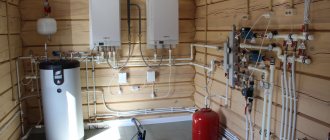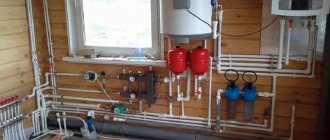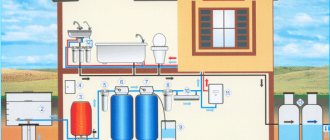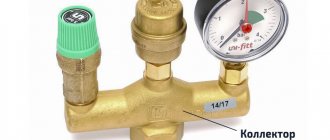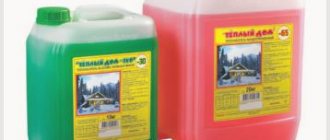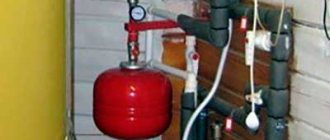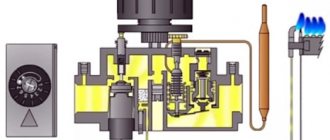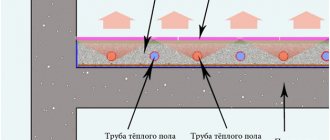The times when gas stoves were connected to rigid metal pipes are long gone and not everyone will even remember this. Nowadays, flexible gas connections are widely used to connect gas-consuming equipment.
Gas hoses are presented in the retail chain in a fairly wide range. Not only pressure hoses made of modern materials are in demand, but also liners, the production of which has been mastered since Soviet times.
Rice. 1 Gas stoves with water supply
Choosing a chimney for a gas boiler
Any wall-mounted gas boiler needs a chimney. Depending on the model, this can be either a traditional chimney or a small horizontal chimney that can be led outside directly through the wall of the house.
Photo 4: Installation of a coaxial chimney for a turbocharged boiler
In double-circuit boilers with an open combustion chamber, the combustion process occurs with the help of air from the room in which the heating device is installed. Typically, such models are installed in specially equipped boiler rooms. To remove combustion products, they are connected to traditional chimneys for gas boilers made of ceramic or stainless steel.
Wall-mounted boilers with a closed combustion chamber (turbocharged) use outside air in their operation. It is supplied inside the device through one of the channels of the coaxial chimney. The second channel is used to discharge flue gases into the atmosphere. A coaxial chimney is very easy to install and you can connect a gas boiler to it yourself.
What is a bellows eyeliner and what are its advantages?
A bellows gas hose is a corrugated pipe made of stainless steel. Special fittings are installed at the ends of the hose to create a strong and safe connection. The connection to the pipes and equipment is secured using union nuts made of the same material. To increase the level of tightness, metal or plastic sealing rings are installed at the joint.
As a rule, sealing gaskets are included in the flexible hose kit.
Eyeliner kit
The advantages of a bellows hose over other types of flexible hoses designed for connecting gas equipment are:
- strength and rigidity. According to manufacturers' requests, the service life of the bellows is up to 25 years;
- possibility of correct operation at different temperatures;
- not exposed to direct sunlight;
- ability to withstand high pressure;
- possibility of stretching, and when the length increases to 50%, the strength of the liner does not decrease.
The disadvantages include the cost of the equipment, which is 2–3 times higher than the price of rubber analogues.
Reliable signs of a fake
Regardless of the type of flexible gas hose, you should ensure the authenticity of the product before purchasing. The fact is that recently cases of defects and counterfeits launched for sale by Chinese manufacturers have become more frequent.
Well-known European brands are usually the targets of counterfeiting. The difference in quality between the original and the fake can be colossal.
It is possible to play it safe and distinguish a quality product from a counterfeit one.
To do this you need:
- take the time to conduct a thorough visual inspection;
- check whether the technical characteristics correspond to those indicated in the product passport;
- require the seller to present quality certificates confirming the safety of the device intended for working with explosive substances;
- do not buy goods at a suspiciously low price, which is not typical for products in this category.
The structure of counterfeit goods may contain dangerous chemical or radioactive impurities. Defective hoses are short-lived and often cause explosions.
Installation of gas supply
Installation of the bellows gas hose is carried out in compliance with the following rules:
- it is unacceptable to hide the liner in the wall, since any leak that is not detected as soon as possible can lead to emergencies, damage to property and loss of life;
- Do not install a hose with a large number of kinks;
- condensation on the equipment will help reduce the service life of the liner.
Installation diagram:
- choosing an installation location in accordance with the recommendations given above;
Optimal connection diagram for a gas stove
- turning off the gas supply to the premises. To make a temporary shutdown, you can use the tap installed in the apartment, and if it is missing, you need to contact the management company;
Individual gas shut-off valve
- dismantle the old eyeliner (if any);
- if the supply line and tap are missing, then before connecting the equipment, it is necessary to cut a thread on the pipe and install a tap that allows you to shut off the gas supply directly in the living room. For example, to troubleshoot equipment;
- dielectric installation;
- A flexible hose is connected to the tap. As a rule, in this situation, the “nut” connection method is used;
When connecting the liner, special attention is paid to installing the sealing gasket. A connection without a gasket will not be completely sealed
To increase the tightness, you can additionally use FUM tape or other similar material.
- connecting the supply to gas equipment using an o-ring. All nuts and fittings must be fixed using an open-end wrench without unnecessary effort. Even slight overtightening can lead to damage to the seal and rapid depressurization;
Connecting the liner to the equipment
- examination. To identify a leak, you can use a soap solution and an ordinary brush (sponge). If soap bubbles appear on the surface when applying the solution, then the connection is not airtight.
Leak detection with soap emulsion
How to connect a gas stove yourself, watch the video.
If you cannot install the equipment yourself, it is recommended to contact gas service specialists. Replacing the eyeliner will cost approximately 300 - 500 rubles.
Bellows gas hose: main advantages
A bellows is an elastic corrugated tube that is particularly rigid. This hose is the most reliable. This type of flexible hose is recommended for installation of equipment by gas services. This is due to the fact that it is characterized not only by a high degree of safety, but also by the longest service life. In addition, it can withstand the heaviest loads created by the gas flow. Therefore, if you ask in shopping centers which gas hose is better, they will most likely offer to buy a bellows.
Helpful advice! Regardless of which flexible gas hose you decide to purchase: metal, PVC or bellows, you must take into account that it must be accompanied by a passport and certificates confirming its quality and safety of use. The minimum cross-section of the hose should not be less than 10 mm, otherwise normal operation of the gas equipment will be impossible.
Bellows hoses bend perfectly and do not change the internal diameter even with significant bending
Despite the fact that the price of a bellows gas hose is several times higher than the cost of other flexible hose options, it is still considered a leader among other types of hoses used for connecting gas stoves and boilers. The price is influenced not only by the manufacturer, but also by the length of the product, as well as the presence of additional options. Thus, some types of products are equipped with an automatic temperature sensor, which in case of violations independently cuts off the flow of gas, which can prevent leakage and fire.
Types of gas taps
In old buildings, two types of cranes were usually installed on vacation:
- petal;
- suberic.
The differences between the designs of these products can be seen in the figure.
When the slab is replaced or the valve fails, it is best to install a new ball valve.
This device is much better, but more expensive. Installation of an Italian faucet will cost $10. You can also install a cheaper domestic faucet, costing $5. They are no worse than their foreign counterparts, but sometimes have defects. Therefore, do not forget to take a receipt with you when purchasing so that you can exchange the defective product for a good one.
Types of gas flexible hoses
The current market offers a fairly extensive list of gas hoses. In addition to the material, you will also need to choose a manufacturer. And in this case it is better not to save. The item is bought once and for a long time. Having saved 500 rubles, you can then spend a lot on health and repairs if the pipe starts leaking gas. Therefore, let’s first look at the varieties.
Rubber-fabric
It has many advantages that allow it to be used in a gas system:
- easy installation;
- good flexibility;
- low cost;
- various sizes;
- excellent electrical insulation.
The disadvantage of such rubber parts is poor rigidity. Today, the industry produces hoses from a special material of high elasticity. Therefore, their service life can reach 10 years.
The cost of such hoses usually does not exceed $7.
Bellows metal
Professional gas fitters consider it the most suitable for gas systems. The service life of such hoses can be more than 25 years. It connects to a gas stove without any difficulty. Bellows systems can be connected to boilers and water heaters, and they are completely safe.
If you have a gas stove equipped with electric ignition in your kitchen, in order to connect the bellows device, a special insulating connection is created between it and the tap.
This type of hose bends freely and can withstand high pressure, reaching 6 atmospheres. It can withstand significant temperature changes ranging from -50 degrees to heating up to 200 degrees. The main disadvantage of a bellows hose is its cost. It is many times higher than similar gas connections.
The advantages of such bellows metal systems include:
- made of stainless steel;
- complies with GOST;
- meets all technical requirements;
- protected from any mechanical influences by a special polymer coating;
- able to withstand any mechanical impact;
- the warranty period exceeds 30 years;
- withstands voltage of 1500 Volts.
Oxygen
It can also be connected to gas stoves, but you need to take into account several very important points:
- The internal diameter must exceed 16 millimeters;
- The surface in contact with oxygen must be well cleaned of oil. Otherwise, the hose will overheat and material damage will occur.
The advantages of oxygen hoses include the following characteristics:
- withstands high pressure. It can reach 20 atmospheres;
- very simple installation;
- low cost;
- rich assortment;
- does not conduct electric current.
What to do if the diameter of the gas pipeline does not match the boiler pipe
Sometimes the inlet on the boiler may not match the diameter of the gas pipeline. For example, the gas pipe of a Navien floor-standing boiler is 1/2″, and the gas pipeline is 3/4″. Is it possible to connect the device using a DU-15 1/2″ bellows connection instead of 3/4″? Such a transition is permissible, since it is local and does not provide significant resistance.
It is impossible to imagine a modern private house, and especially an apartment in an apartment building, without gas equipment. This could be a stove, a heating boiler, a heating boiler, or other household appliances.
Gas is supplied to a house or apartment through a pipeline system, and from it to each individual consumer via flexible connections. Flexible gas supply can be made in several versions at once.
Metal-plastic for gas
Metal-plastic pipes can also be used for gas supply. The inside of pipes of this type is made of polyethylene, which is already familiar to us.
Due to the fact that metal-plastic pipes are supplied in coils, it becomes possible to lay a fairly long gas pipeline without using a large number of connections.
If the pipes still need to be connected, then only press fittings must be used. With their help, you can ensure the tightness of the connection, which will retain its properties for a long time. However, to make such a connection you will need a special device.
This is a must know valuable advice
Before purchasing a flexible hose, it is necessary to check the size of the thread at the outlet of the plate, its classification and whether it is straight or angular. If the outlet is of a direct type (directed into the wall), you must purchase a sleeve with a square at the end.
The gas hose should not be painted - this will accelerate its cracking. A more attractive look can be created by covering it with special paper or oilcloth.
It is also strictly forbidden to tightly seal gas communications with false plasterboard panels and other structures - this will make it difficult to carry out service work on individual elements.
To camouflage the gas supply system, a collapsible box is used, which can be easily dismantled if necessary. In this case, there will be constant access to all structural elements of the gas system.
It is forbidden to use unnecessary connections. Independent complication of a gas structure, according to technical regulations, may entail a fine or disconnection from gas supply
If a technician was called to connect the gas stove, it is necessary to check that the work was performed correctly: the excess tap from the tap at the lower end should be unscrewed, the flexible line should be directly connected exclusively to the tap located on the branch pipe, and its other end - only to the outlet of the gas stove.
It is also possible to use an adapter. Any additional installations are prohibited.
Installation requirements
The necessary conditions:
- The hose must be accessible.
- It is prohibited to connect several devices to one flexible element.
- The soft element is allowed to sag and twisting is not allowed.
- Docking is ensured by a threaded connection. Welding and soldering are not used.
- If there is a metal braid, it is necessary to prevent the presence of condensation on its surface.
- The gas hose is replaced after the end of its service life. This standard is set by the manufacturer.
It is better to entrust the installation of the connection to specialists to prevent leakage of the substance.
Instructions for self-connection
Paying a gas technician for installation work is not too high, but many home craftsmen prefer to do everything themselves. This is a feasible task that requires the purchase of components and theoretical knowledge.
To connect, you will also need to prepare the following tools and buy materials:
- keys: gas No. 1, adjustable 22-24;
- a screwdriver for tightening the clamp, if required;
- sealants (Loctite 55 thread, flax, FUM - tape);
- gasket ½;
- gas sleeve;
- ball valve 1/2′;
- a brush and soap solution, which will be required to control the work.
A rag and a plastic stopper will also come in handy. The rag will be used as a temporary seal against gas leaks. The narrowed edge of the plug must be adjusted to fit the hole in the supply pipe. If during the extraction process a homemade part gets stuck, you can easily remove it with a corkscrew.
Step #1: Removing the old slab
Shutting off the crane when lowering is a primary task to ensure the safety of the work being performed. Next, you need to unscrew the locknut located on the outlet and remove the coupling. If the old slab has a coupling and locknut that were previously painted, this will significantly complicate the process of dismantling them.
Sometimes it is not possible to complete this procedure, then you will need to cut the eyeliner with a grinder.
The gas stove is dismantled after disconnecting the gas main from the conductor pipe. Difficulties that arise with unscrewing the lock nut on a metal pipe can be solved by cutting off the liner
In the process of unscrewing the squeegee located in the lowering valve, it is necessary to hold the valve itself with a key. It does not have to be removed unless you plan to replace the faucet. When they plan to delay the installation of the slab, an additional plug is installed on the lower side.
Step #2: Replace the faucet
There are situations when the wall is located very close to the tap and there is no way to dismantle it. In this case, it is necessary to bend the fastening and install a wedge between the wall and the pipeline. However, this is done in such a way that it is possible to continue doing the work.
It is necessary to prepare a piece of rag sufficient to completely block the pipe after dismantling the old tap. The next thing will be to tear it off without completely unwinding it. You will also need to prepare the selected type of seal. Do not forget to thoroughly ventilate the room during work to eliminate gas vapors.
After unscrewing the tap, the outlet from the pipe is tightly fixed with a finger and then with a wet rag. The main actions are aimed at eliminating gas escape from the pipe as much as possible. In this case, the thread on the branch should not be closed, since it will be covered with the selected sealant.
Before winding the seal, the threads on the lower end must be thoroughly cleaned. Next, its winding is carried out directly. This process ensures a reliable and airtight fixation of the new faucet, which is then tightly screwed on. The last step is to install the previously removed handle on the faucet.
Using soap foam, the tightness of the connection of the faucet and the gas pipe is checked. If the work was completed correctly, installation of the gas hose can continue.
If gas equipment is connected to the mains for the first time, you will definitely need to call a gas technician. In his presence, the equipment is checked for gas leaks when the valve is open. If the gas service worker does not find any violations, he must enter the established brand of stove into the register.
Step #3: Connecting the Flex Hose to the Stove
The external thread of the hose fitting is wrapped with a sealant. After this, it must be screwed into the tap on the branch pipe. The flexible hose is connected to the manifold at the finishing stage.
Next, the stage of test opening the tap on the lower side is mandatory to check for gas leaks. Using soap foam, the joints are treated with a brush. If foaming occurs when opening the gas tap, the work must be redone.
It is necessary to check the threads located on the manifold of the plate. Quite often it is 3/8′. In this case, you will need to install a 1/2′ adapter with a seal
When the work of replacing a gas hose is carried out in a private house where bottled gas is used, an additional replacement of the nozzle with a smaller diameter will be required. If this is not done, the burners will produce too much soot, which likes to settle on furniture and dishes in the kitchen.
How to choose eyeliner
When independently choosing a bellows-type liner for any gas equipment, you must consider:
- type of hose;
- technical parameters of the liner;
- equipment manufacturer.
Types of bellows liners
To connect gas, use:
- metal bellows hoses;
- metal hoses with PVC coating.
Types of gas hoses
There are no fundamental differences between the types according to technical data. Hoses with polymer protection are more leak-proof and have a longer period of use (up to 30 years).
Selection of technical parameters
A flexible pipe for gas is selected depending on the following parameters:
- working temperature. Most bellows gas hoses are capable of operating at temperatures from -55°C to +250°C;
- pressure inside the gas pipeline. Bellows flexible hoses can withstand internal pressure up to 6 atmospheres, which allows you to select a device for connecting any type of gas equipment;
According to current regulatory documents, the pressure in gas supply networks cannot be more than 0.03 atmospheres.
- hose length;
- connection method. Hoses can be equipped with union-nut or nut-nut pairs. The fitting is equipped with an external thread, and the nut is equipped with an internal thread. As a rule, a fitting is used to connect the supply to gas equipment, and a nut is used to connect to gas supply pipes.
Methods for connecting gas supply
thread size. Hoses are available with 15 mm (1/2 inch), 20 mm (3/4 inch), 25 mm (1 inch), 32 mm (1 1/4 inch) threads. If the thread size on the connection does not correspond to a similar parameter on the connected equipment, then you will have to install an additional adapter that will help reduce the level of tightness of the gas supply system.
Popular manufacturers
In order for the gas supply to last for a long period, it is important to choose the right equipment manufacturer that guarantees the quality of the products. The most popular are:. Italian company EMIFLEXp.a
The manufacturer's products are certified by Rostest and approved by Gostekhnadzor. Gas hoses can be used to transport liquefied and natural gas, provided the temperature ranges -
Italian company EMIFLEXp.a. The manufacturer's products are certified by Rostest and approved by Gostekhnadzor. Gas hoses can be used to transport liquefied and natural gas, provided the temperature ranges -
°C – +100°C and pressure up to 7 atmospheres;
The Chinese company Tuboflex also specializes in producing high-quality eyeliners that are less expensive than their Italian counterparts. Hoses are certified;
Hose from EMIFLEX
- G-BEKA (Türkiye). Gas connections are characterized by their low cost, large margin of safety and the ability to be used at any temperature up to +250°C. Working pressure – up to 6 atmospheres;
- OSCAR-M (China). Inexpensive products with decent quality that can be used for household purposes.
When is it better to use polyethylene pipes?
If you plan to lay a gas pipeline in the ground, then in this case you cannot do without polyethylene pipes. Steel pipes in this case are not the best option, since, when laid in the ground, they are vulnerable to corrosive processes.
In theory, both cross-linked and regular polyethylene can be used to make gas lines. However, cross-linked polyethylene is hardly used as there is no benefit from it being more durable and heat resistant. But its price is higher when compared with ordinary low-density polyethylene.
In a store, identifying polyethylene pipes that can be used for gas supply is quite simple. A yellow line is drawn along their entire length.
It is worth noting that polyethylene compression fittings are not used on gas connections. Their mechanical strength is limited, and it is not worth completely excluding the possibility that no external influences will be exerted on the gas pipe.
Sleeve connections, for which either rubber seals or glue are used, are also not suitable. Most often, this method is used when it is necessary to connect PVC pipes intended for sewage. They are not suitable for gas because they do not guarantee complete tightness.
All that remains is to use three types of fittings:
- brass, which provide both tightness and mechanical strength;
- fittings for welding, which are connected with a soldering iron at low temperatures (it is recommended to set the temperature to 240 degrees Celsius);
- electric welded, on which spirals have already been applied, intended for melting contact surfaces. They are expensive but can guarantee a high quality connection.
Piping a gas boiler in the heating system
After the wall-mounted gas boiler has been installed and the heating device is placed on the wall, the first thing you need to do is connect it to the heating system. Depending on which model is installed, single-circuit or double-circuit, there are different piping schemes. We will look at the connection process using the example of a wall-mounted double-circuit gas boiler.
Photo 1: Connection diagram for a wall-mounted double-circuit gas boiler
As you know, a double-circuit boiler, in addition to heating, is capable of producing hot water for household needs. Structurally, this is realized by installing one bithermal or two separate heat exchangers. A double-circuit boiler does not produce very much hot water, but it is quite enough for 1-2 distribution points (for example, a kitchen faucet and shower).
A modern wall-mounted gas boiler is very compact and already contains within itself the basic elements necessary for the operation of a heating system with forced circulation, such as: a circulation pump, an expansion tank, a safety group. In the heating systems of small private country houses, this is more than enough, but if necessary, you can install an additional expansion tank or another pump.
At the bottom of any mounted double-circuit boiler there are 5 pipes. They are connected to: supply and return lines of the heating system, supply and return of hot water supply, main gas. The gas connection is usually located in the center and is colored yellow. All other lines can be located in any order, depending on the model of the gas boiler. Therefore, before starting tying, it is necessary to clarify the purpose of each of them in the operating instructions.
Photo 2: Piping diagram for a wall-mounted double-circuit gas boiler
The piping of a wall-mounted gas boiler is done with polypropylene or metal pipes. The cross-section of heating pipes is usually larger than DHW pipes 3/4 and 1/2 inches, respectively. The heating system is connected to the boiler through American nuts. Ball valves are installed on each line for the convenience of dismantling the gas boiler without draining the coolant and to isolate the boiler from the heating system if necessary. To ensure tightness, all connections must be made using plumbing FUM tape or flax.
Coarse filters must be installed in the heating return line and in the DHW supply line. For ease of washing and cleaning, they are also cut off by shut-off valves. Often, in order to increase the service life of the secondary heat exchanger of a double-circuit boiler, a magnetic fine filter is additionally installed at the DHW supply.
Which is better
When choosing a gas hose for connecting equipment, you must proceed from the operating conditions. If you plan to install it at your dacha under a balloon system, then a rubber version is allowed. You should inspect it carefully at the time of purchase. The rubber should not be thin, as it will quickly tear.
At home, when connecting to a boiler, it is better to give preference to the stainless steel option. In this case, attention is drawn to the following points:
- Presence of yellow dots on the metal braid. Only such hoses are suitable for gas boilers and other similar equipment.
- Before making a purchase, the required length is measured in advance.
- The gas product kit should include 2 union nuts, which are called American nuts.
Optimal size options: diameter ½ or ¾” and length 1-2 m.
How to choose the right gas hose
It is necessary to purchase such devices only in special stores that have certificates for each product.
The gas hose braid should have a yellow mark. It is placed only on the gas hose; on the water hose, a blue-red line is placed.
All hoses come in different sizes to accommodate a wide range of connections. The most common range is one to two meters. Usually, fastening threads are made with dimensions of 1/2″–3/4″.
The ends can be equipped with two nuts. The so-called nut-nut, sometimes a nut with a fitting. This hose is called a “nut-fitting”. A nut with an internal thread is called a female; a fitting with an external thread is called a male.
Connecting a gas cylinder to a stove how to connect a gas cylinder to a stove
Not everyone will afford to build a country mansion with all the amenities. Some of the population are content with small plots with wooden houses, where they come on weekends. There is no point in running a gas pipe to the house, and it is expensive, but connecting a gas cylinder to the stove will come in handy. And it’s inexpensive, and you can do it yourself.
Do you know what needs to be done to properly connect the cylinder to the stove? If not, then after reading this article to the end, it will not be difficult for you to make the connection yourself.
What you need to connect
- Gas stove. She must not be quite old. Be sure to check the integrity of connections and burners.
- Gas reducer (30 mbar). Experts consider gearboxes with threaded connections and brass nuts to be the most reliable.
- Gas hose. It should be 1.5 meters longer. For example, if there are 5 meters from the installation site of the slab to the cylinder, then you will need 6.5 m; this is necessary so that the hose is not connected under tension, so it can crack faster.
- Fittings and clamps for connections. This will be needed if you decide to use an old stove; new models already come with such adapters.
- The tool must be copper-plated or brass-plated. Safety rules provide for working with gas connections only with such keys; they do not give a spark in case of accidental failure.
- As an additional sealing material, you will need flax or fum tape.
- Soap solution.
A special gas hose must be used for connection. When purchasing in a store, explain this to the seller. Under no circumstances should you use an old hose that was lying in your basement; even if it looks good, it may have internal cracks and the consequences will be disastrous.
Work order
We will assume that the stove in the kitchen is already installed. The gas cylinder must be placed in another room or at least 5 meters away from the stove. The place for the cylinder must be clean and prepared. Build a special mount from wooden slats.
Connection to plate
First you need to connect the hose to the stove. This is a completely safe job. We screw it onto the hose of the stove, tighten it with a clamp and, screwing the fum tape onto the inlet fitting of the stove, wrap it until it stops.
Connection to cylinder
First you need to install a reducer on the cylinder. It is screwed onto a special adapter with the accompanying wrapping of fum tape.
The entire connection process must take place with a thorough inspection of each part:
- There should be no contamination on the gearbox and the cylinder, especially at the threaded connections.
- The hose deserves special attention. In addition to the appropriate length, it should not have cracks or narrowing, and do not allow it to twist. It is also better to replace it after the expiration date.
- There should be no rust on the clamps during operation; this can lead to their rupture. If corrosion appears, it is better to immediately replace them or purchase specialized ones with anti-corrosion treatment.
Steel pipes
Pipes of this type are used when laying out a gas pipeline from the central pipeline to houses. They are installed above the ground.
In this case, only black steel pipes can be used. Galvanized pipes are not suitable. The outside of the pipes is primed and painted, which protects them from corrosion.
The inner surface of the pipe does not require additional treatment, because it will contain a minimum content of water vapor, and there will be no access to oxygen at all.
Steel pipes can be connected using traditional methods using welding or threaded fittings. The latter can be made of either brass or cast iron.
To seal the connection, it is necessary to rewind the threads. In places where there are bends, locknuts are used as seals. The sealing material can be soft and high-temperature resistant FUM tape.
When sealing a threaded connection with tape, it is necessary to take into account that you should not apply much effort during assembly. If you decide to turn the fitting even slightly in the opposite direction along the thread, it will be difficult to avoid gas leakage.
